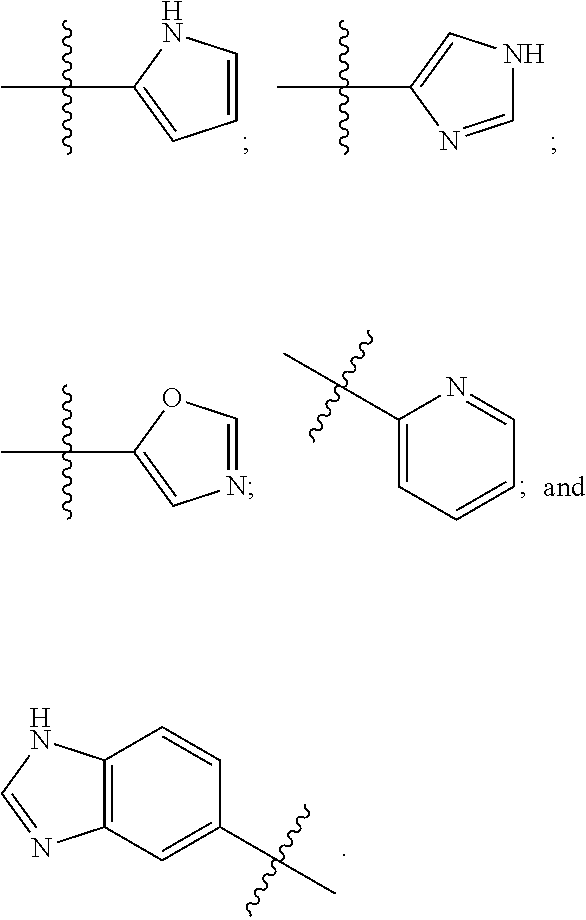Human protein tyrosine phosphatase inhibitors and method of use
a technology of tyrosine phosphatase and human protein, which is applied in the field of human protein tyrosine phosphatase inhibitors and methods of use, can solve the problems of exacerbated pathological conditions, bleeding and blindness, and the molecular mechanisms of this process are still not fully understood
- Summary
- Abstract
- Description
- Claims
- Application Information
AI Technical Summary
Benefits of technology
Problems solved by technology
Method used
Image
Examples
example 1
{4-[2-(S)-(4-Ethylthiazol-2-yl)-2-(2-phenylacetylamido)ethyl]phenyl}sulfamic acid (5)
Preparation of [1-(S)-carbamoyl-2-(4-nitrophenyl)ethyl]carbamic acid tert-butyl ester (1): To a 0° C. solution of 2-(S)-tert-butoxycarbonylamino-3-(4-nitrophenyl)-propionic acid and N-methylmorpholine (1.1 mL, 9.65 mmol) in DMF (10 mL) is added dropwise iso-butyl chloroformate (1.25 mL, 9.65 mmol). The mixture is stirred at 0° C. for 20 minutes. after which NH3 (g) is passed through the reaction mixture for 30 minutes at 0° C. The reaction mixture is concentrated and the residue dissolved in EtOAc, washed successively with 5% citric acid, water, 5% NaHCO3, water and brine, dried (Na2SO4), filtered and concentrated in vacuo to a residue that is triturated with a mixture of EtOAc / petroleum ether to provide 2.2 g (74% yield) of the desired product as a white solid.
Preparation of [2-(4-nitrophenyl)-1-(S)-thiocarbamoylethyl]carbamic acid tert-butyl ester (2): To a solution of [1-(S)-carbamoyl-2-(4-nitrop...
example 2
4-((S)-2-(2-(3-chlorophenyl)acetamido)-2-(2-(thiophene-2-yl)thiazol-4-yl)ethyl)phenylsulfamic acid (10)
Preparation of (S)-[3-diazo-1-(4-nitrobenzyl)-2-oxo-propyl]-carbamic acid tert-butyl ester (6): To a 0° C. solution of 2-(S)-tert-butoxycarbonylamino-3-(4-nitrophenyl)-propionic acid (1.20 g, 4.0 mmol) in THF (20 mL) is added dropwise triethylamine (0.61 mL, 4.4 mmol) followed by iso-butyl chloroformate (0.57 mL, 4.4 mmol). The reaction mixture is stirred at 0° C. for 20 minutes and filtered. The filtrate is treated with an ether solution of diazomethane (−16 mmol) at 0° C. The reaction mixture is stirred at room temperature for 3 hours then concentrated in vacuo. The resulting residue is dissolved in EtOAc and washed successively with water and brine, dried (Na2SO4), filtered and concentrated. The residue is purified over silica (hexane / EtOAc 2:1) to afford 1.1 g (82% yield) of the desired product as a slightly yellow solid. 1H NMR (300 MHz, CDCl3) δ 8.16 (d, J=8.7 Hz, 2H), 7.39 (...
example 3
(S)-4-(2-(2,3-Diphenylpropanamido)-2-(4-ethylthiazol-2-yl)ethyl)-phenylsulfamic acid (12)
Preparation of (S)—N-[1-(4-ethylthiazol-2-yl)-2-(4-nitrophenyl)ethyl]-2,3-diphenyl-propanamide (11): To a solution of 1-(S)-(4-ethylthiazol-2-yl)-2-(4-nitrophenyl)ethyl amine hydrobromide, 3, (0.95 g, 2.65 mmol), diphenylpropionic acid (0.60 g, 2.65 mmol) and 1-hydroxybenzotriazole (HOBt) (0.180 g, 1.33 mmol) in DMF (10 mL) at 0°, is added 1-(3-dimethylaminopropyl)-3-ethylcarbodiimide (EDCI) (0.502 g, 2.62 mmol) followed by triethylamine (1.1 mL, 7.95 mmol). The mixture is stirred at 0° C. for 30 minutes then at room temperature overnight. The reaction mixture is diluted with water and extracted with EtOAc. The combined organic phase is washed with 1 N aqueous HCl, 5% aqueous NaHCO3, water and brine, and dried over Na2SO4. The solvent is removed in vacuo to afford 0.903 g (70% yield) of the desired product which is used without further purification.
Preparation of (S)-4-(2-(2,3-diphenylpropanamid...
PUM
| Property | Measurement | Unit |
|---|---|---|
| Volume | aaaaa | aaaaa |
| Volume | aaaaa | aaaaa |
Abstract
Description
Claims
Application Information
 Login to View More
Login to View More - R&D
- Intellectual Property
- Life Sciences
- Materials
- Tech Scout
- Unparalleled Data Quality
- Higher Quality Content
- 60% Fewer Hallucinations
Browse by: Latest US Patents, China's latest patents, Technical Efficacy Thesaurus, Application Domain, Technology Topic, Popular Technical Reports.
© 2025 PatSnap. All rights reserved.Legal|Privacy policy|Modern Slavery Act Transparency Statement|Sitemap|About US| Contact US: help@patsnap.com



